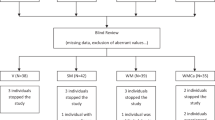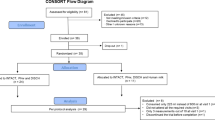Abstract
Background/Objectives:
Postprandial lipaemia is an established risk factor for atherosclerosis. To investigate the acute effect of four milk-derived dietary proteins (alpha-lactalbumin, whey isolate, caseinoglycomacropeptide and whey hydrolysate) on postprandial lipaemia, we have conducted a randomized, acute, single-blinded clinical intervention study with crossover design.
Subjects/Methods:
A total of 11 obese non-diabetic subjects (age: 44–74, BMI: 30–41.4 kg m-2) were included. On 4 different days the subjects ingested a high-fat meal with the following energy distribution: 66% energy from fat (100 g of butter), 15% of energy from carbohydrate (90 g of white wheat bread) and 19% of energy from protein (45 g of pure protein). Our primary variable was plasma triglyceride measured in the 8-h postprandial period. Secondarily, retinyl palmitate, non-esterified free fatty acids, glucose, insulin, glucagon, GLP-1 and GIP, active and total grehlin and cholecystokinin were measured.
Results:
We observed no statistically significant (P=0.8) differences between meals on our primary variable that is, triglycerides. Whey hydrolysate was associated with a significantly (P=0.02) smaller postprandial suppression of non-esterified free fatty acids compared with the other dietary proteins.
Conclusion:
We did not observe significant differences in postprandial lipaemia to the four milk-derived dietary proteins. Whey hydrolysate caused less postprandial suppression of free fatty acids.
This is a preview of subscription content, access via your institution
Access options
Subscribe to this journal
Receive 12 print issues and online access
$259.00 per year
only $21.58 per issue
Buy this article
- Purchase on Springer Link
- Instant access to full article PDF
Prices may be subject to local taxes which are calculated during checkout
Similar content being viewed by others
References
Akhavan T, Luhovyy BL, Brown PH, Cho CE, Anderson GH. (2010). Effect of premeal consumption of whey protein and its hydrolysate on food intake and postmeal glycemia and insulin responses in young adults. Am J Clin Nutr 9, 966–975.
Bansal S, Buring JE, Rifai N, Mora S, Sacks FM, Ridker PM. (2007). Fasting compared with nonfasting triglycerides and risk of cardiovascular events in women. JAMA 298, 309–316.
Bergman RN, Ader M. (2000). Free fatty acids and pathogenesis of type 2 diabetes mellitus. Trends Endocrinol Metab 11, 351–356.
Biesalski HK. (1990). Separation of retinyl esters and their geometric isomers by isocratic adsorption high-performance liquid chromatography. Methods Enzymol 189, 181–189.
Blomhoff R, Green MH, Green JB, Berg T, Norum KR. (1991). Vitamin A metabolism: new perspectives on absorption, transport, and storage. Physiol Rev 71, 951–990.
Brader L, Holm L, Mortensen L, Thomsen C, Astrup A, Holst JJ et al. (2010). Acute effects of casein on postprandial lipemia and incretin responses in type 2 diabetic subjects. Nutr Metab Cardiovasc Dis 20, 101–109.
Calbet JA, Holst JJ. (2004). Gastric emptying, gastric secretion and enterogastrone response after administration of milk proteins or their peptide hydrolysates in humans. Eur J Nutr 43, 127–139.
Calbet JA, MacLean DA. (2002). Plasma glucagon and insulin responses depend on the rate of appearance of amino acids after ingestion of different protein solutions in humans. J Nutr 132, 2174–2182.
Chen YD, Reaven GM. (1991). Intestinally-derived lipoproteins: metabolism and clinical significance. Diabetes Metab Rev 7, 191–208.
Claessens M, Saris WH, van Baak MA. (2008). Glucagon and insulin responses after ingestion of different amounts of intact and hydrolysed proteins. Br J Nutr 100, 61–69.
Couillard C, Bergeron N, Prud’homme D, Bergeron J, Tremblay A, Bouchard C et al. (1998). Postprandial triglyceride response in visceral obesity in men. Diabetes 47, 953–960.
Field BC, Chaudhri OB, Bloom SR. (2010). Bowels control brain: gut hormones and obesity. Nat Rev Endocrinol 6, 444–453.
Floyd Jr JC, Fajans SS, Pek S, Thiffault CA, Knopf RF, Conn JW. (1970). Synergistic effect of essential amino acids and glucose upon insulin secretion in man. Diabetes 19, 109–115.
Frid AH, Nilsson M, Holst JJ, Björck IM. (2005). Effect of whey on blood glucose and insulin responses to composite breakfast and lunch meals in type 2 diabetic subjects. Am J Clin Nutr 82, 69–75.
Guerci B, Vergès B, Durlach V, Hadjadj S, Drouin P, Paul JL. (2000). Relationship between altered postprandial lipemia and insulin resistance in normolipidemic and normoglucose tolerant obese patients. Int J Obes Relat Metab Disord; 24, 468–478.
Holst JJ. (1982). Evidence that enteroglucagon II is identical with the C-terminal sequence residues 33-69 of glicentin. Biochem J 207, 381–388.
Karpe F, Bell M, Björkegren J, Hamsten A. (1995). Quantification of postprandial triglyceride-rich lipoproteins in healthy men by retinyl ester labeling and simultaneous measurement of apolipoproteins B-48 and B-100. Arterioscler Thromb Vasc Biol 15, 199–207.
Karpe F, Boquist S, Tang R, Bond GM, de Faire U, Hamsten A. (2001). Remnant lipoproteins are related to intima-media thickness of the carotid artery independently of LDL cholesterol and plasma triglycerides. J Lipid Res 42, 17–21.
Kolovou GD, Mikhailidis DP, Kovar J, Lairon D, Nordestgaard BG, Ooi TC et al. (2011). Assessment and clinical relevance of non-fasting and postprandial triglycerides: an expert panel statement. Curr Vasc Pharmacol 9, 258–270.
Krarup T, Madsbad S, Moody AJ, Regeur L, Faber OK, Holst JJ et al. (1983). Diminished immunoreactive gastric inhibitory polypeptide response to a meal in newly diagnosed type I (insulin-dependent) diabetics. J Clin Endocrinol Metab 56, 1306–1312.
Lairon D, Play B, Jourdheuil-Rahmani D. (2007). Digestible and indigestible carbohydrates: interactions with postprandial lipid metabolism. J Nutr Biochem 18, 217–227.
Lairon D. (2008). Macronutrient intake and modulation on chylomicron production and clearance. Atheroscler Suppl 9, 45–48.
Lam TK, van de Werve G, Giacca A. (2003). Free fatty acids increase basal hepatic glucose production and induce hepatic insulin resistance at different sites. Am J Physiol Endocrinol Metab 284, E281–E290.
Madhu SV, Kant S, Srivastava S, Kant R, Sharma SB, Bhadoria DP. (2008). Postprandial lipaemia in patients with impaired fasting glucose, impaired glucose tolerance and diabetes mellitus. Diabetes Res Clin Pract 80, 380–385.
Mortensen LS, Hartvigsen ML, Brader LJ, Astrup A, Schrezenmeir J, Holst JJ et al. (2009). Differential effects of protein quality on postprandial lipemia in response to a fat-rich meal in type 2 diabetes: comparison of whey, casein, gluten, and cod protein. Am J Clin Nutr 90, 41–48.
Neary MT, Batterham RL (2009). Gut hormones: implications for the treatment of obesity. Pharmacol Ther 124, 44–56.
Nilsson M, Stenberg M, Frid AH, Holst JJ, Björck IM. (2004). Glycemia and insulinemia in healthy subjects after lactose-equivalent meals of milk and other food proteins: the role of plasma amino acids and incretins. Am J Clin Nutr 80, 1246–1253.
Nordestgaard BG, Benn M, Schnohr P, Tybjaerg-Hansen A. (2007). Nonfasting triglycerides and risk of myocardial infarction, ischemic heart disease, and death in men and women. JAMA 298, 299–308.
Orskov C, Jeppesen J, Madsbad S, Holst JJ. (1991). Proglucagon products in plasma of noninsulin-dependent diabetics and nondiabetic controls in the fasting state and after oral glucose and intravenous arginine. J Clin Invest 87, 415–423.
Power O, Hallihan A, Jakeman P. (2009). Human insulinotropic response to oral ingestion of native and hydrolysed whey protein. Amino Acids 37, 333–339.
Rabe-Hesketh S . (2008). Multilevel and Longitudinal Modeling Using Stata. Stata Press: TX.
Ruge T, Hodson L, Cheeseman J, Dennis AL, Fielding BA, Humphreys SM et al. (2009). Fasted to fed trafficking of Fatty acids in human adipose tissue reveals a novel regulatory step for enhanced fat storage. J Clin Endocrinol Metab 94, 1781–1788.
Sehested TS, Hansen TW, Olsen MH, Abildstrøm SZ, Rasmussen S, Ibsen H et al. (2010). Measures of overweight and obesity and risk of cardiovascular disease: a population-based study. Eur J Cardiovasc Prev Rehabil 17, 486–490.
Teucher B, Rohrmann S, Kaaks R. (2010). Obesity: focus on all-cause mortality and cancer. Maturitas 65, 112–116.
Thomsen C, Rasmussen O, Lousen T, Holst JJ, Fenselau S, Schrezenmeir J. (1999). Differential effects of saturated and monounsaturated fatty acids on postprandial lipemia and incretin responses in healthy subjects. Am J Clin Nutr; 69, 1135–1143.
van Wijk JP, Halkes CJ, Erkelens DW, Castro Cabezas M. (2003). Fasting and daylong triglycerides in obesity with and without type 2 diabetes. Metabolism 52, 1043–1049.
Westphal S, Kästner S, Taneva E, Leodolter A, Dierkes J, Luley C. (2004). Postprandial lipid and carbohydrate responses after the ingestion of a casein-enriched mixed meal. Am J Clin Nutr 80, 284–290.
Yusuf S, Hawken S, Ounpuu S, Bautista L, Franzosi MG, Commerford P et al. (2005). Obesity and the risk of myocardial infarction in 27 000 participants from 52 countries: a case-control study. Lancet 366, 1640–1649.
Acknowledgements
We wish to thank Tove Skrumsager and Lene Trudsø for excellent technical assistance. This work is carried out as a part of the research program of the Danish Obesity Research Centre (DanORC, see http://www.danorc.dk) and is supported by Nordic Centre of Excellence (NCoE) programme (Systems biology in controlled dietary interventions and cohort studies—SYSDIET, P number, 070014). Supported by ‘Marie Krogh Center for Metabolic Research’, Life Sciences, Copenhagen University. Supported by a grant from Arla Foods Ingredients amba, Viby, Denmark.
Author information
Authors and Affiliations
Corresponding author
Ethics declarations
Competing interests
J Holmer-Jensen, LS Mortensen and K Hermansen received a shared research grant from Arla. A Astrup is a scientific member of Global Dairy Platform (Chicago) and has received speaker's honoraria and research funding from the Danish Dairy Foundation, Arla and Danish Meat Association. None of the other authors had a conflict of interest to disclose.
Rights and permissions
About this article
Cite this article
Holmer-Jensen, J., Hartvigsen, M., Mortensen, L. et al. Acute differential effects of milk-derived dietary proteins on postprandial lipaemia in obese non-diabetic subjects. Eur J Clin Nutr 66, 32–38 (2012). https://doi.org/10.1038/ejcn.2011.142
Received:
Revised:
Accepted:
Published:
Issue Date:
DOI: https://doi.org/10.1038/ejcn.2011.142
Keywords
This article is cited by
-
A pre-meal of whey proteins induces differential effects on glucose and lipid metabolism in subjects with the metabolic syndrome: a randomised cross-over trial
European Journal of Nutrition (2019)
-
Whey protein lowers systolic blood pressure and Ca-caseinate reduces serum TAG after a high-fat meal in mildly hypertensive adults
Scientific Reports (2018)
-
Intakes of whey protein hydrolysate and whole whey proteins are discriminated by LC–MS metabolomics
Metabolomics (2014)
-
Metabolite profiling and beyond: approaches for the rapid processing and annotation of human blood serum mass spectrometry data
Analytical and Bioanalytical Chemistry (2013)



